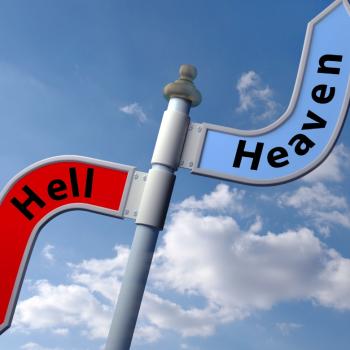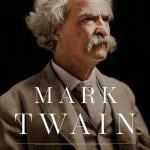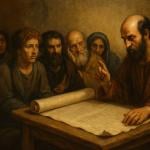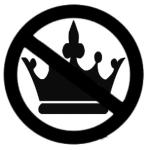TODAY IN GOD:
RELIGION NEWS BITES FOR YOUR SNACKING PLEASURE
____________________________________________________________________________________
Biblical sex — it could knock your socks off
Let him kiss me with the kisses of his mouth. For your love is better than wine.
Song of Songs 1:2
Almost everything we think we know about the Bible and sex is wrong.
Instead of being a list of sexual shalt-nots, the Bible contains so much graphic eroticism that parents may want to keep the sacred text away from youth under age 18.
Indeed, that’s what 2,000 Hong Kong residents tried to do in May when they called on a Chinese decency commission to restrict the Bible to adults only because it contains passages that seem to give the okay to incest, rape, adultery and a father offering his daughters to strangers for sexual gratification.
The Bible — which has been the foundation for much of the world’s sex-related laws — is actually, it seems, quite erotic, and surprisingly soft on things like prostitution and polygamy.
And even though some Bible passages criticize homoeroticism, others non-judgmentally describe prominent men loving other men in a sensual way. The Bible, as well, frequently employs sexual communion as a metaphor for how humans can passionately relate to God.
As if that’s not enough to shatter prim and proper stereotypes, the Bible contains sections such as the Songs of Songs, which highlight sensual delight in ways that could snap open the eyes of unwary adults, let alone children.
Even though the protesting Hong Kong residents were trying to make a wry point about the dangers of Chinese government censorship, The Song of Songs from the Hebrew Bible (which Christians call the Old Testament) is, really, quite hot. It makes 38 metaphorical references to male and female genitals and includes several cheery accounts of oral sex. It does not mention God once.
For good and ill, what we think the Bible says about sex matters a great deal.
In the U.S., the Bible and sex is at the root of the politically manipulated “culture wars.” Canadian laws on everything from marriage to abortion were, until recently, governed by how people read the Bible.
FOR THE FULL STORY (DOUGLAS TODD IN THE VANCOUVER SUN) CLICK HERE
Vatican: Thou Shalt Cool Thy Road Rage
VATICAN CITY — The Vatican, taking a detour from its usual pronouncements on faith and morals, on Tuesday (June 19) issued a set of “Drivers’ `Ten Commandments”‘ in an effort to promote greater traffic safety.
The commandments were part of a document, “Guidelines for the Pastoral Care of the Road,” published by the Pontifical Council for the Pastoral Care of Migrants and Itinerant People.
Noting that some 35 million people were killed in traffic accidents over the course of the 20th century — often due to “downright stupid and arrogant behavior by drivers or pedestrians” — the document proclaims the need for a “road ethics” based on “theological, ethical, legal and technological principles.”
The Drivers’ “Ten Commandments” include:
I. You shall not kill.
II. The road shall be for you a means of communion between people and not of mortal harm.
III. Courtesy, uprightness and prudence will help you deal with unforeseen events.
IV. Be charitable and help your neighbor in need, especially victims of accidents.
V. Cars shall not be for you an expression of power and domination, and an occasion of sin.
VI. Charitably convince the young and not so young not to drive when they are not in a fitting condition to do so.
VII. Support the families of accident victims.
VIII. Bring guilty motorists and their victims together, at the appropriate time, so that they can undergo the liberating experience of forgiveness.
IX. On the road, protect the more vulnerable party.
X. Feel responsible towards others.
FOR THE FULL STORY (RELIGION NEWS SERVICE VIA BELIEFNET) CILICK HERE
‘What Would Jesus Buy?’ film faces tough sell
SILVER SPRING, Md. – The makers of ”What Would Jesus Buy?” have a problem – how do you sell a film documenting performance artist Rev. Billy and his Stop Shopping Gospel Choir on a guerrilla U.S. tour against consumerism?
The film follows the white-suited, big-haired Rev. Billy and his 35-member choir as they hit the road in two biodiesel-fueled buses in December 2005.
They invade shopping malls, megastores and Starbucks coffee shops with a message preached in mock-religious fervor that there is evil – a looming “shopocalypse” – at the heart of U.S. consumer culture.
Rev. Billy tries to “exorcise” discount chain Wal-Mart’s home office in Arkansas. He is arrested in Disneyland on Christmas Day after marching with his red-robed choir and denouncing the Walt Disney Corp. for outsourcing merchandise production.
In an outlet of lingerie shop Victoria’s Secret, known for its blizzard of catalog promotions, Rev. Billy exhorts, “O Victoria, we know your secret – we don’t need a million catalogs a day to have our sexual fantasies.”
The movie has received early praise and has solid credentials, including executive producer Morgan Spurlock, who scored big with “Super Size Me,” a movie targeting McDonald’s fast food.
But director Rob VanAlkemade said the movie’s message makes it a tough sell to potential distributors.
“Major distributors have backed away because Wal-Mart pushes half of their DVDs,” VanAlkemade said after a sold-out screening of the movie Sunday at the Silverdocs documentary festival near Washington.
Starbucks – a frequent target of Rev. Billy which got a court order to keep him out of its California stores – pulled out as a sponsor of Silverdocs. The festival is presented by the American Film Institute and the Discovery Channel.
FOR THE FULL STORY (REUTERS VIA SAN DIEGO UNION-TRIBUNE) CLICK HERE
Classes preach pronunciation to foreign-born priests
One recent morning at the Cathedral Shrine of the Virgin of Guadalupe, some Dallas-area priests were busy minding their p’s and q’s – as well as their t’s, w’s and r’s.
The Rev. Roberto Butawan was working on mastering the “th” sound. Although he was taught English as a child in the Philippines, he’s now trying to learn how to talk like an American.
It’s a challenging task, but one that’s vital to his calling.
“I need to be understood,” said Fathttp://www.blogger.com/img/gl.link.gifher Butawan, who serves at the Prince of Peace Catholic Community in Plano. “Being a missionary, the primary task is to preach and to bring the Gospel of Christ to the people.”
He’s part of an “accent reduction” class that’s being offered by Dallas diocese for the growing number of foreign-born priests who are making up for a shortage of homegrown clergymen.
Currently, 46 out of the 111 priests serving in Dallas-area parishes are from foreign countries, and the number is likely to grow.
In the past, priests have followed the waves of Catholic immigrants to American shores. But now, the Father Flanagans are increasingly being replaced by Father Nguyens and Father Moonjanattus.
FOR THE FULL STORY (DALLAS MORNING NEWS) CLICK HERE
Charges Mulled Against `Da Vinci Code’
Vatican City — Italian prosecutors have reportedly opened an
investigation that could lead to criminal obscenity charges against
makers of the movie “The Da Vinci Code.”
According to the Italian newspaper La Repubblica, the public
prosecutor’s office in the city of Civitavecchia is investigating
charges that the movie’s references to Jesus Christ and the Virgin Mary
violate the Italian penal code’s prohibition against the “publication of
obscene spectacles.”
Director Ron Howard and nine other persons, including the film’s
Italian importer and distributors, will be required to answer
investigators’ queries, the paper reported.
The Civitavecchia prosecutor’s office would neither confirm nor deny
the reports Monday (June 18), explaining that the status of pending
criminal investigations is not public information.
The investigation was reportedly initiated in response to complaints
from local clergy. Particularly offensive, according to lawyers who
filed the complaint, are the film’s assertion that Jesus Christ fathered
a child and its suggestion that the Holy Grail, in Leonardo da Vinci’s
painting of “The Last Supper,” symbolizes the Virgin Mary’s womb.
FOR THE FULL STORY (RELIGION NEWS SERVICE VIA BELIEFNET) CLICK HERE
VA Tech shooter’s writings mangle religion
Federal agents investigating the April 16 shootings at Virginia Tech think Seung Hui Cho displayed many of the same characteristics of a criminal behavioral profile called the “Collector of Injustice,” or someone who considers any misfortune against him the fault or responsibility of others.
Agents from the Bureau of Alcohol, Tobacco, Firearms and Explosives also think Cho mentally and physically tried to transform himself into an alter ego he called “Ax Ishmael” before his rampage.
In the days and weeks leading up to the massacre of 32 students and faculty members, Cho changed his personality from passive to active. On the morning of the shootings, which the agents say were motivated by a vendetta against society, he tried to further erase his identity by deleting his Hotmail account from his computer. In addition, he removed the hard drive, and investigators have not been able to find it, the agents say.
When police found Cho’s body inside a Norris Hall classroom, the words “Ax Ishmael” were scrawled in red on his left arm, and notes and tapes he left also referred to them….
Investigators think “Ax Ishmael” is based on the biblical figure Ishmael, the son of Hagar, a maidservant to Sarah, and the prophet Abraham. Ishmael lived as an outcast, and his brother Isaac was favored. Writings that Cho left in his dorm room, sent to the Virginia Tech English Department and mailed to NBC reveal twisted references to religion as part of his identity.
Cho, 23, of Centreville, whose family was religious and had sought help for him from a Woodbridge church, repeatedly made religious references. He said that he had been “crucified” and that, as with Jesus, his actions would set people free. He called himself a “martyr” who would “sacrifice” his life. He wrote that he would go down in history as the “Jesus Christ of the Weak and Defenseless.” He thought his actions would inspire others to fight back and get even.
Among the writings, Cho included three pictures of himself, which investigators think show how his self-image progressed. In the first picture, he is smiling. In the next, his arms are outstretched like Jesus’s on the cross. And in the third, his arms are crossed as if he is lying dead in a coffin, agents said.
As part of his physical transformation, investigators have said, he methodically bought weapons and clothes for his killing spree. They have documented his purchases in detail, from the cargo pants he wore in Norris Hall to the hundreds of rounds of ammunition he carried and his visits to a nearby firing range.
When he was ready, he wrote: “I am Ax Ishmael.”
Police have not discovered why he uses the word “Ax,” but his writings suggest he identified with Ishmael. According to some religious scholars, Ishmael held his brothers in contempt, despised the rituals of society and considered himself to be free of social control.
The writings also reveal that Cho had decided to strike out against those who had committed what he perceived were injustices against him: “I say we take up the cross, Children of Ishmael, take up our guns and knives . . . and take no prisoners and spare no lives.”
FOR THE FULL STORY (WASHINGTON POST) CLICK HERE
God’s work is an expensive enterprise
Sometimes a life of virtue does not pay. Years of abstemiousness among its members means that the Church of England’s defined-benefit pension scheme is suffering the same problem as all others, but magnified: its members live even longer than the rest of us.
Shaun Farrell, the secretary of the Church’s pensions board, says: “The clergy is actuarially assessed as living two years longer than the rest of the population. It’s the virtuous lives they lead.”
Ageing ministers are not the Church’s only problem. Old buildings are also a drain on finances. With 45 per cent of the UK’s Grade I listed buildings under its care, the Church faces huge annual bills for their upkeep.
Canon David Houlding of All Hallows Church in Gospel Oak, North London, and his flock must scrape together at least £20,000 a year to keep their place of worship, designed in 1890 by James Brooks, the celebrated Victorian architect, in tiptop condition. Canon Houlding says: “I have a small congregation and large expenses.”
The Church of England is like any other business – a £1 billion-a-year one at that, with 13,000 parishes, 43 cathedrals, 16,000 parish churches and 18,000 active and retired workers. Funding for such a huge organisation comes from two main sources; the collection plate provides about 75 per cent and each parish pays a “parish share” to the local diocese. Each diocese then pays some cash to the national church to cover expenses such as training new priests and mission work.
Over the past five years, parishes have increased their giving by about £100 million to cover higher pensions and stipendary costs, and richer areas must subsidise poorer ones. Fêtes, bazaars and open days, Canon Houlding says, remain vital ways of bringing in extra funding. “My parishioners don’t just keep me; they pay over the odds to keep other clergy for parishes that couldn’t afford to pay their priests,” he says.
Rowan Williams, the Archbishop of Canterbury, is poorly paid by chief executive standards, receiving a stipend of £67,790. Canon Houlding costs his parish in total about £52,000 a year he estimates. In retirement, priests have a pension of about £12,000 a year to look forward to. Final-salary pension schemes have been hit by falling investment markets and rapid increases in life expectancy. Clerical pensions accrued before 1998 are paid from a wider pool of church cash, while post1998 benefits come from a separate fund.
At the end of last year there was £482 million under management, about £125 million less than needed to keep retired priests out of penury.
FOR THE FULL STORY (THE FIRST IN A SERIES IN THE UK TIMES) CLICK HERE















